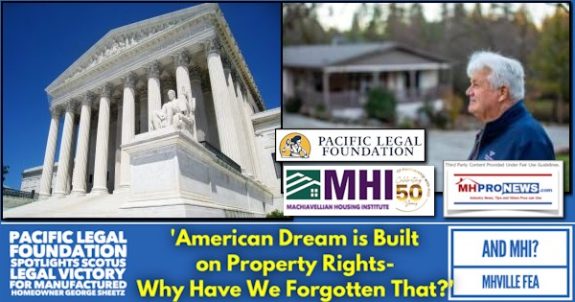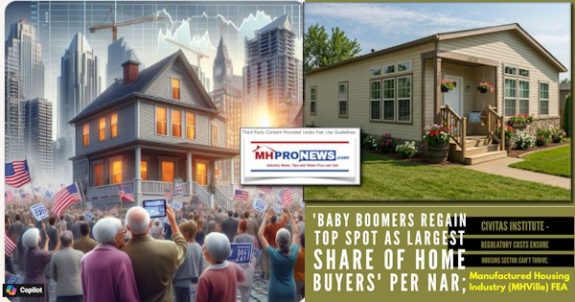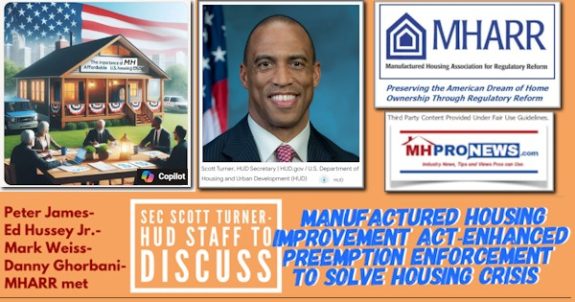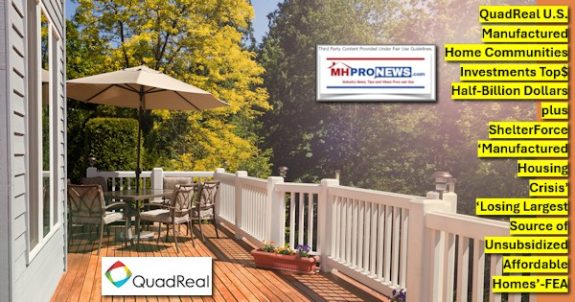Top National News
Senators Want to Move Forward With Fannie, Freddie Reform
As part of a revamp of the mortgage finance market, a bipartisan group of senators is pushing to largely eliminate Fannie Mae and Freddie Mac. Lawmakers and industry representatives reportedly are closing in on a broad framework that would wind down and ultimately dissolve the two government-sponsored enterprises (GSEs). The goal is to reduce the federal government’s role in the housing finance market and encourage more private capital. Such a transition is expected to take a number of years. Sen. Bob Corker (R-Tenn.) states, “Obviously, we’re discussing lots of options, but I don’t know of anybody that’s working on an option where Fannie and Freddie are what they are today.” A more likely outcome would see the GSEs replaced with a new, smaller, and more contained entity — one that would still allow government guarantees on some loans.
From “Senators Want to Move Forward With Fannie Mae, Freddie Mac Reform”
The Hill (05/18/13) Needham, Vicki
Buying More Beneficial Than Renting in 64 Percent of Metros
A new report from Zillow finds that in 64 percent of U.S. metro areas, buying a home is more economical than renting for residents who plan to stay put for at least three years. In the first quarter, Miami, Detroit, and Phoenix offered the shortest breakeven horizon — the point at which buying becomes more affordable than renting — among the 30 biggest metros; while New York, Boston, and San Jose offered the longest. “Locally high home value appreciation in many areas, combined with historically low mortgage rates and low home prices relative to recent peaks, has made buying a home a more advantageous financial decision than renting for many would-be buyers,” said Zillow chief economist Dr. Stan Humphries. The time it takes to recoup upfront costs will be less in areas where residential values are expected to rise quickly, and the breakeven period will be shorter. The breakeven horizon will be longer in metros where home values are expected to rise slowly or even fall.
From “Buying More Beneficial Than Renting in 64 Percent of Metros”
Housing Wire (05/16/13)
US Housing Affordability Remains Steady for the First Quarter of 2013, NAHB Report
Housing affordability remains exceptionally high, based on the National Association of Home Builders/Wells Fargo Housing Opportunity Index (HOI). During the first three months of 2013, a total of 73.7 percent of existing and new homes were sold to families earning the median income of $64,400. The percentage is slightly below the 74.9 percent recorded a year ago, but the HOI has not dipped below 70 in four years. Ogden, Indianapolis, and Syracuse were some of the most affordable markets; while San Francisco was the least affordable. “The bottom line is that, for consumers who can qualify for a mortgage at today’s attractive rates, the majority of homes being sold remain within their grasp in markets nationwide,” said NAHB chief economist David Crowe.
From “US Housing Affordability Remains Steady for the First Quarter of 2013, NAHB Report”
Realty Today (05/15/13) Gupta, Rapti
Home-Builder Confidence Index Gains as Housing Market Strengthens
The National Association of Home Builders’ index of housing market sentiment turned out a reading of 44 this month, up three points from April. The increase not only reflected improvements in current sales conditions and expectations but also gains in the numbers of prospective buyers touring model homes. Even so, any reading below 50 indicates that more builders continue to view market conditions as negative rather than positive. All three components of the index gained in May, with the current-sales index up four points, the index of prospective-buyer traffic rising three points, and a measure of expectations for future sales climbing a single point. NAHB Chairman Rick Judson observed, “Builders are noting an increased sense of urgency among potential buyers as a result of thinning inventories of homes for sale, continuing affordable mortgage rates and strengthening local economies. This is definitely an encouraging sign even amidst rising challenges with regard to the cost and availability of building materials, lots and labor.”
From “Home-Builder Confidence Index Gains as Housing Market Strengthens”
Los Angeles Times (05/15/13) Lazo, Alejandro
Industry News
Lawmakers Fight to Save Financing for Manufactured Homes
Lawmakers in Washington D.C. are fighting to obtain more financing for manufactured homes, a segment of the market that receives little national attention despite its role in providing affordable housing.
Congressman Stephen Fincher, R-Tenn., along with Reps. Bennie Thompson, D-Miss. and Gary Miller, R-Calif. introduced the bipartisan Preserving Access to Manufactured Housing Act to protect the availability of financing for affordable manufactured housing to protect the more than 22 million Americans living in manufactured homes.
The bill would amend the Dodd-Frank Wall Street Reform and the Consumer Protection Act to change the criteria by which home loans are classified as “high-cost” while keeping in place strong consumer protections.
“Low-income families across the country, particularly in rural areas, depend on access to financing for affordable manufactured homes,” said Nathan Smith, chairman of the Manufactured Housing Institute.
Smith added, “Not only are manufactured homes the largest form of unsubsidized affordable housing in the nation, but the manufactured housing industry is also a job creator and an important economic driver in many communities. We thank Representatives Fincher, Thompson and Miller for fighting to protect manufactured homeowners and our industry.”
From “Lawmakers Fight to Save Financing for Manufactured Homes”
Housing Wire (04/29/13) Hopkins, Megan
Prebuilt Loan Predicament
A provision of the Dodd-Frank financial reform law that is intended to protect consumers from abusive lending could inadvertently eliminate an affordable option for many home buyers: manufactured housing. The Consumer Financial Protection Bureau’s definition of “high-cost” lending under the law will in many cases extend to financing deals for manufactured home purchases. Those borrowers typically pay interest of 10 percent or more compared to the current average of 3.5 percent for traditional-home buyers. The high-cost label — and the fewer legal protections that come with it — likely will deter lenders from making manufactured housing loans and, thus, curtail demand for prebuilt homes. However, Sen. Sherrod Brown (D-Ohio) notes that manufactured homes “represent a different product, with a different consumer base” than loans for conventional homes. To avert the loss of housing options, particularly for low-income buyers in remote areas, he and House legislators intend to propose legislation that would classify fewer loans as high-cost.
From “Prebuilt Loan Predicament”
Wall Street Journal (04/24/13) P. C11 Zibel, Alan
Oak Creek Homes Responds to Permian Basin Affordable Housing Shortage
Oak Creek Homes has opened its 17th Texas location in Midland and will be offering manufactured and modular homes and oilfield accommodations that have been built at the company’s two Dallas – Fort Worth metroplex manufacturing facilities. According to general manager Craig Johnston, the shortage of affordable housing in the area, coupled with “escalating apartment rental costs,” weighed heavily in Oak Creek’s decision to open a home center in the area. He noted that all of the homes produced at the new location “will include both the company’s exclusive 7-Year Home Guard Service Protection Plan and [the] unique Quality Care home installation program which incorporates a 47-point on-site inspection performed by a licensed engineer.” The company has built more than 50,000 homes, said chief marketing officer Ronnie Richards, and “prices start in the low $30,000 [sic] and range up to spacious triple section homes with over 3,000 square feet in the $150,000 range.” The Ruggedized oilfield accommodations, which the company offers in addition to its line of residential homes, are custom designed and built to handle the demands of the oil patch and can be delivered in a minimum of 30 days.
From “Oak Creek Homes Responds to Permian Basin Affordable Housing Shortage”
MySanAntonio.com (05/05/13)
Kitchen Cabinetry, Finishes Visualizer Added by Champion Homes
Champion Home Builders used the Midwest Manufactured Housing Show in Louisville, Ky., to introduce retailers to its Kitchen Designer home design visualizer. With manufactured home design having become so stylized, the tool will help buyers select from a myriad of cabinet and countertop options. Customers will be able to use the resource through the retailer’s Web site, which Champion online marketing manager Paul Perugi says “provides our partners with a powerful selling advantage.” Retailers responded favorably to the software at the housing show, he adds.
From “Kitchen Cabinetry, Finishes Visualizer Added by Champion Homes”
Woodworking Network (04/21/13) Vruno, Mark
Acquisitions Bulk Up Local Manufactured Housing Companies RHP, Sun
Southeast Michigan is home to the headquarters of some of the biggest owners of manufactured housing communities (MHCs); and an ongoing trend towards consolidation has allowed a couple of them, RHP Properties and Sun Communities, to grow even larger. In April 2013, RHP became the largest privately held owner and operator of MHCs in the country when it completed an $865 million acquisition of 71 properties in Florida, New York, and Salt Lake City. It previously had spent $333 million for 36 MHCs with 6,300 home sites in the Denver area and in Wyoming. The company now holds a $2.25 billion portfolio of 231 MHCs with 51,000 home sites in 25 states. According to COO John McLaren, Sun Communities has purchased two portfolios totaling about $271.8 million over the past two years. In the 20 years since it went public, the company has grown nearly six-fold and is now the owner and operator of 183 communities with more than 67,000 home sites nationwide. McLaren has expressed optimism about the impact that improving occupancy rates will have for the company’s future; in Michigan alone, occupancy at Sun properties has climbed to 86.4 percent at the end of the 2013 first quarter from 79 percent occupancy at the end of 2010.
From “Acquisitions Bulk Up Local Manufactured Housing Companies RHP, Sun”
Crain’s Detroit Business (05/05/2013) Pinho, Kirk
Arizona Cities Near Top for Manufactured Homes
A new report from the U.S. Census Bureau covering 2009-2011 found that of 131.8 million various types of residential units nationwide, 8.6 million were manufactured homes. The largest inventory of these homes was determined to be in Farmington, N.M., where they accounted for 32 percent of the metropolitan area’s total housing supply. Yuma, Ariz., and Lake Havasu City-Kingman, Ariz., rounded out the top three slots — with 29 percent and 26.7 percent of their housing units being manufactured homes, respectively. Of all the metro regions in the country, these three were the only ones where more than a quarter of the housing inventory was comprised of manufactured homes. Part of the reason that Farmington has such a high percentage is that the entire metro area was examined by the study, including San Juan County and the Navajo Nation. Theresa McBee, president of the San Juan Board of Realtors, also attributed the high number to the fact that more than two-thirds of the county’s roughly 129,000 people live outside Farmington across 5,500 square miles of rugged, rural terrain; and manufactured homes tend to be more affordable for those in remote areas. Both the Lake Havasu City-Kingman area and the Yuma area likely have a large percentage of manufactured homes because of the significant, transient population of snowbirds and vacationers.
From “Arizona Cities Near Top for Manufactured Homes”
TriValley Central (AZ) (05/15/13)
MaryAnne Gilmartin Touts Housing as Signature Innovation of Atlantic Yards
Forest City Ratner’s Atlantic Yards mixed-use development in New York will feature modular housing, the element that incoming CEO MaryAnne Gilmartin says will “revolutionize the project.” According to her, the decision to go modular was driven by the desire for innovation and the company’s commitment to affordable housing. Atlantic Yards’ first 32-story highrise will claim the title of the world’s tallest prefabricated building.
From “MaryAnne Gilmartin Touts Housing as Signature Innovation of Atlantic Yards”
The Real Deal (05/02/13) Samtani, Hiten
MHI News
MHI Member Assistance Needed in Securing Co-Sponsors to H.R. 1779
In April, Reps. Stephen Fincher (R-TN), Bennie Thompson (D-MS) and Gary Miller (R-CA) introduced the Preserving Access to Manufactured Housing Act (H.R. 1779). The measure would amend provisions of the Dodd-Frank Wall Street Reform and Consumer Protection Act that would curtail the availability of credit needed by those seeking to purchase manufactured housing. Over the coming weeks, Sen. Sherrod Brown (D-OH) is expected to introduce companion legislation in the Senate. Additional information will be provided at that time.
Specifically, the bill would revise the High-Cost Mortgage triggers for manufactured home loans, and make clarifications to the Loan Originator definition as it applies to manufactured home retailers and salespeople. These two areas of the law – which are scheduled to become effective January 2014 – would substantially reduce lender ability to originate manufactured home loans.
Assistance is needed from MHI members and others within the manufactured housing industry in contacting their Representatives to request they co-sponsor H.R. 1779. A detailed issue brief/action alert, along with a sample letter that can be faxed to Congressional offices, can be found on the MHI Web site at www.manufacturedhousing.org.
• If you are unsure who your U.S. Representative is, use the search tool on the U.S. House of Representative’s Web site at www.house.gov.
• Support from members of the House Financial Services Committee is particularly important. Manufactured housing industry members with Representatives on this committee are asked to contact these Representatives ASAP to request they co-sponsor H.R. 1779. Visit the House Financial Services Committee Web site at financialservices.house.gov/about/members.htm to view a roster of the committee members.
• Highlighting the manufactured housing presence in your state is an effective way of underscoring the important role manufactured housing plays in the larger housing market. Visit the U.S. Census Web site atwww.census.gov/fastfacts/ to search the level of manufactured housing by state and county. Be sure to also mention the role your business plays in providing jobs and homes in your community!
MHI is grateful for the dedicated assistance provided by its members in working to secure bipartisan support for this important legislation. MHI thanks industry members and state associations in California, Mississippi and Tennessee for again working with Reps. Fincher, Thompson and Miller to secure their commitment to reintroduce this important legislation.
MHI members can contact Jason Boehlert at jboehlert@mfghome.org or (703) 558-0660.
Dodd-Frank and CFPB Updates
U.S. Bank Launches Lobbying Effort in Support of Manufactured Housing Relief Legislation
In tandem with its existing advocacy activities seeking relief from the Dodd-Frank Act, U.S. Bank has officially begun broad lobbying efforts to assist MHI in passing House and Senate legislation that would maintain access to the credit needed to purchase manufactured housing. The full-scale involvement of U.S. Bank’s government relations team in Washington, DC will provide needed assistance to the manufactured housing industry’s efforts. MHI thanks long-time industry supporter and Financial Services Division and Board of Governors member Scott MacFarlane for his dedicated work in securing U.S. Bank’s corporate support of MHI’s efforts.
Fannie and Freddie Activity to be Limited to QM-Space
On May 6th, the Federal Housing Finance Administration (FHFA) announced that beginning in January 2014, Fannie Mae and Freddie Mac would be limited to purchasing home loans that meet requirements laid out in the ability-to-repay final rule issued by the CFPB in January 2013. Fannie Mae and Freddie Mac will no longer purchase a loan that is subject to the “ability to repay” rule if the loan:
• is not fully amortizing;
• has a term of longer than 30 years; or
• includes points and fees in excess of three percent of the total loan amount, or such other limits for low balance loans as set forth in the rule.
For more information, click here to access the FHFA news release.
Mel Watt Nominated to FHFA Post
On May 1st, President Obama announced his intention to nominate Congressman Mel Watt (D-NC) to serve as Director of the Federal Housing Finance Agency (FHFA), which serves as the conservator of Fannie Mae and Freddie Mac. The nomination of Watt has reenergized the debate over how to wind down the GSEs and reform the nation’s housing finance system.
Watt was nominated, in large part, due to his support of calls to provide principal reductions for homeowners that are under water on their mortgages. The nomination has been largely criticized by Republicans, citing Watt’s inexperience and past efforts to oppose reform of the GSEs.
The Senate Banking Committee is expected to take up the nomination in the coming weeks.
CFPB Issues More Compliance Guides
On May 7th, the CFPB issued Small Entity Compliance Guides on its mortgage-related rules. In addition to its guide on the ability-to-repay and qualified mortgage rule at http://files.consumerfinance.gov/f/201304_cfpb_compliance-guide_atr-qm-rule.pdf,
the CFPB has now issued Small Entity Compliance Guides on the:
• Escrow rule for higher-priced mortgages
• TILA higher-priced mortgages appraisal rule
Each of the guides indicates that it is intended to provide a summary of the underlying rule that “highlights issues” that small creditors, and their partners or others that work with them, “might find helpful to consider when implementing the rule.” Each guide also cautions that it is not a substitute for the underlying rule.
MHI members can contact Jason Boehlert at jboehlert@mfghome.org or (703) 558-0660.
HUD Solicits for New Monitoring Contract for the Manufactured Housing Program
On April 29th, the Department of Housing and Urban Development (HUD) issued a Request for Proposal (RFP) for a new monitoring contract for the Manufactured Housing Program. HUD is seeking a qualified organization to assist HUD in performing assessment inspections, monitoring, and evaluation of the performance of private and state agencies responsible for oversight of design and construction of manufactured housing, and for monitoring the performance of states assisting HUD in the enforcement of its Standards and Regulations. This effort includes parallel and concurrent monitoring of the In-Plant Production Primary Inspection Agencies (IPIAs) and Design Approval Primary Inspection Agencies (DAPIAs) and assessment inspections of the 37 State Administrative Agencies (SAAs).
The 68 page solicitation outlines detailed tasks to be undertaken by the contractor, including the following:
• Development of IPIA and DAPIA audit procedures.
• Perform In-Plant audits.
• Analyze In-Plant Audit Reports.
• Conduct post production follow-up audits on retailer and/or consumer sites.
• Provide for state participation in IPIA Inspections.
• Provide annual review of IPIA audit procedures and enforcement regulations.
• Manage label program.
• Conduct DAPIA reviews on at least 10 percent of the design approvals submitted by each DAPIA.
• Review and monitor State Administrative Agencies (SAAs).
The solicitation calls for performance for one year with an option to extend to four years. According to HUD’s budget, it plans to spend approximately $1.5 million for a four year contract. A recent HUD “industry day” resulted in significant interest by a number of organizations.
Any qualified business or organization interested in this business opportunity is encouraged to apply. At the recommendation of MHI, HUD extended the deadline for submission of proposals from May 14, 2013 to June 3, 2013 at 3:00 p.m. EST.
Click here to view the solicitation.
EPA’s Pending Guidance on Clean Water Act Regulation May be Withdrawn
The EPA is reconsidering its 2011 proposed Clean Water Act guidance which would increase the number of waters, streams, and wetlands under its regulatory jurisdiction. The guidance has been stalled at the White House Office of Management and Budget for more than a year. Critics, including a wide coalition of industry groups and members of Congress, have argued that EPA’s guidance goes beyond its authority and would adversely impact the cost of building housing.
In late April 2013, thirty Senators sent a letter to the Acting EPA Administrator urging the Administration to scrap its controversial guidance for clarifying oversight of wetlands and other water resources as EPA prepares to take up a rulemaking on the issue. The administration has indicated that it is currently considering whether to issue interim guidance as it continues with the rulemaking — a process that could last for much of the rest of the Obama administration — or drop the guidance altogether.
The letter recommends that EPA withdraw the proposed guidance and proceed with a formal rulemaking process that should not attempt to expand its statutory authority beyond that intended by Congress. The final rule should reflect the principles promulgated in recent case law and identify limits on the agency’s jurisdiction under the Clean Water Act.
MHI will continue to monitor this issue and work with a broad coalition on legislative and regulatory initiatives to stop the apparent overreach of congressional authority.
HUD and DOJ Issue Guidance on Accessibility Requirements for Multifamily Housing
On April 30, 2013, the Department of Housing and Urban Development (HUD) and the Department of Justice (DOJ) issued new guidance regarding the Fair Housing Act requirement that multifamily housing be designed and constructed so that it is accessible to persons with disabilities.
The Fair Housing Act prohibits discrimination in housing based on disability, race, color, national origin, religion, sex, and familial status. The Fair Housing Act also requires that multifamily housing built for first occupancy after March 1991 contains accessible features for persons with disabilities.
The new guidance is intended to assist design professionals, developers and builders in understanding and meeting their obligations and to assist persons with disabilities in understanding their rights regarding the “design and construction” requirements of the Fair Housing Act.
Under the Fair Housing Act, all multifamily housing built for first occupancy after March 1991 must include:
• Public and common use areas that are readily accessible to and usable by persons with disabilities;
• Doors that are designed to allow passage into and within all premises of covered dwellings and that are sufficiently wide to allow passage by persons with disabilities, including persons who use wheelchairs;
• An accessible route into and through the dwelling unit;
• Light switches, electrical outlets, thermostats, and other environmental controls in accessible locations;
• Reinforcements in bathroom walls to allow the later installation of grab bars; and
• Usable kitchens and bathrooms such that an individual using a wheelchair can maneuver about and use the space.
According to HUD, more than 30 million Americans use a wheelchair or have difficulty walking or climbing stairs. Since January 2009, HUD and its Fair Housing Assistance Program partners have investigated and either conciliated or charged 300 cases that alleged violations of the design and construction requirements of the Fair Housing Act. The Justice Department’s Civil Rights Division has filed 141 cases to enforce the Fair Housing Act since January 2009, 19 of which have alleged discrimination based on a failure to design and construct multifamily housing in compliance with the Act.
Click here to read the HUD and DOJ’s Guidance.
Click here for more information on Fair Housing Laws.
RV and MH Leaders Gather to Celebrate Major Milestone
More than 400 leaders of the recreational vehicle and manufactured housing industries gathered at the RV/MH Hall of Fame in Elkhart, Indiana on May 9th to celebrate a special fundraising milestone with a “Burn the Bank Note” event.
On Tuesday, April 30th, with less than 12 hours to go and $20,000 shy of meeting the $50,000 challenge grant from the family of Robert “Boots” Ingram to retire the RV/MH Hall of Fame’s bank loan, two industry “angels” stepped forward, one with a $15,000 donation and the other with a $5,000 donation, meeting the goal of raising $150,000. The Ingram family had offered a $50,000 challenge grant if supporters of the Hall of Fame could raise contributions totaling $150,000 by April 30th.
As a result of these and other actions, the leadership of the RV/MH Hall of Fame burned the bank note of $840,000 at the celebratory event.
“Our President Darryl Searer and the Board of the RV/MH Hall of Fame have accomplished a lot this year, but burning this bank note is a very special occasion,” stated Barry Cole, chairman of the board for the RV/MH Hall of Fame. “I want to offer a big thanks to those who have helped us achieve this special fundraising goal. And it is only a matter of time before we will be able to pay off the building and be completely debt free.”
“It’s a great day for the RV/MH Hall of Fame,” Searer stated. “During my year at the Hall of Fame, we have made significant progress in securing the financial health of this important institution and we can now look forward to building a new future of the Hall of Fame. I offer my sincere thanks to all those who have made this possible.”
Securing A New Future for the RV/MH Hall of Fame
Under the leadership of Searer and the RV/MH Hall of Fame Board of Directors, they have made an impressive turnaround in the financial health of the Hall. Just one year ago, the Hall of Fame was facing a debt of approximately $5.5 million. Through their collective efforts, the Hall’s debt has been reduced significantly to just $2.6 million.
The turnaround is due in part to cutting expenses (including Searer volunteering his time and energy), increased contributions from industry members, and increased income from the Hall’s meeting facility – The Northern Indiana Event Center – which has seen its rental revenues increase by more than 300% from last year.
At the same time, Searer has focused on increasing consumer involvement in the Hall of Fame. Special promotional efforts with the Family Motor Coach Association have seen the number of Hall of Honor lifetime memberships increase by 429 members generating over $18,000 during the past 30 days.
“Our industry should be very proud of the RV/MH Hall of Fame and the wonderful home we have created here,” Searer stated. “While we have worked hard, we have also had a tremendous amount of fun, and we are well along the road to ensuring a solid financial footing for the Hall of Fame.”
“The RV members have really stepped up to burn the bank note on the final day and now I want to challenge the members of the manufactured housing industry to also step forward and show their support for the Hall of Fame,” noted Cole. “We have created a special facility that honors and preserves the strong history of the manufactured housing and recreational vehicle industries. Now, with the significant steps we have taken over the past year, especially today’s “Burn the Bank Note” celebration, we are ensuring that this special home can move forward with confidence. But we need each and every member of the manufactured housing industry to show their financial support to reach our ultimate goal of being debt-free. “There are many ways to contribute, so please go to web sitewww.rvmhhalloffame.org and donate what you feel appropriate. Also, please feel welcome to attend the 2013 class induction ceremony August 5th.”


























